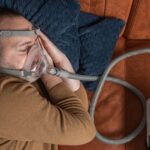Introduction
Can I go to the ER for a panic attack is a frequently asked question of patients with panic disorder. Panic attacks can be terrifying and overwhelming, prompting many to seek emergency room (ER) treatment. The ER can treat many medical emergencies, but you should know when and why to go for a panic attack. At the same time, we should also know why not go to ER. This article will explain when an ER visit for a panic attack is appropriate and offer advice on managing and seeking help for panic attacks.
When to Seek Emergency Medical Care for a Panic Attack
It can be hard to tell when to seek emergency medical help during a panic attack. Most panic attacks can be managed with proper treatment and coping techniques, but some require immediate medical attention.
If one is in immediate danger or has severe symptoms that impair their ability to function, they should seek medical attention. Chest pain, tightness, rapid heart rate, intense shortness of breath, and extreme dizziness may occur.
Panic attacks may mimic heart attacks or blood clots. Those with a family history of heart disease or risk factors should seek medical attention immediately. If physical symptoms last long or are accompanied by other concerns like sudden weakness or difficulty speaking, go to the emergency room.
Panic attacks are not life-threatening, but if untreated they can cause complications. Frequent panic attacks can lower the quality of life and mental health. Seeking medical help can reassure and help create an individualized treatment plan for panic attacks and anxiety disorders.
Overall, seek emergency medical care for a panic attack if severe symptoms impair one’s ability to function, if there is a family history of heart disease or risk factors, or if other symptoms are present. Quick medical attention can diagnose and treat panic attacks, reducing complications and improving mental health.
Why should I avoid going to ER Frequently for panic attacks?
Here comes another problem. Despite the similarity of the symptoms between panic attacks and other medical conditions, it is important for a physician to be confident about the diagnosis of panic attacks. Patients with panic attacks have extreme fear of death and devastating medical illness. With this fear in mind, they need frequent reassurances. They go to emergency frequently. They go for ECG and other laboratory tests again and again. Most of the time, these tests are normal. They have a long list of doctors’ visits. We call these behaviors as safety-seeking behavior. These kinds of behaviors are one of the main reasons responsible for prolonging the panic disorder. If we are confident about the diagnosis of a panic attack, We should avoid going to ER frequently
Symptoms of Anxiety and Panic Attacks
Panic attacks and anxiety are common mental health issues that can affect daily life. These conditions cause intense fear or worry, often with chest pains, shortness of breath, or rapid heart rate. Recognizing anxiety and panic attack symptoms helps find treatment and support. Understanding these symptoms can help anxiety and panic disorder sufferers and their loved ones.
Physical Symptoms of Anxiety and Panic Attack
Physical symptoms and intense fear and anxiety characterize anxiety and panic attacks. These symptoms may be alarming and similar to other psychiatric conditions.
Anxiety and panic attacks can cause chest pain, a rapid pulse, profuse sweating, labored breathing, and chills or hot flashes. These symptoms can be distressing and mimic heart attacks and other cardiovascular issues.
These physical symptoms can be scary, but they are rarely medical emergencies. However, if you have chest pain or other symptoms, you should see a doctor to rule out medical issues.
It’s important to distinguish anxiety, panic attacks, and other psychiatric disorders. Agoraphobia, caffeine or nicotine dependence, obsessive-compulsive disorder, phobias, post-traumatic stress disorder, separation anxiety disorder, and social anxiety disorder may have similar physical symptoms to anxiety and panic attacks.
Anxiety and panic attacks can cause chest pain, rapid pulse, profuse sweating, labored breathing, chills, and hot flashes. These symptoms may resemble other psychiatric disorders. To rule out medical issues, seek medical attention if you have worrying symptoms.
Psychological Symptoms of Anxiety and Panic Attack
A variety of distressing psychological symptoms occur during anxiety and panic attacks. One of the main symptoms is a sense of impending doom. This fear often seems irrational and unwarranted. Individuals may also feel detached from reality, as if they are watching themselves or their surroundings, causing unreality or depersonalization.
Anxiety is another common psychological symptom. Raced thoughts may anticipate the worst in any situation. This worry can consume you and disrupt your life. Many people with anxiety and panic attacks feel helpless or crazy because they feel like they’re losing control.
Note that these psychological symptoms may overlap with other psychiatric conditions. For instance, agoraphobia—fear of being in places where escape is difficult—can cause intense fear and worry. OCD can cause intrusive and distressing thoughts and a need to perform rituals or compulsions to prevent harm. Irrational fears of objects or situations can cause severe anxiety. After a traumatic event, post-traumatic stress disorder (PTSD) causes intrusive memories, nightmares, hypervigilance, fear, and detachment. Due to intense fear and avoidance of social interactions, social anxiety disorder has similar psychological symptoms.
In summary, anxiety and panic attacks cause fear, detachment, and intense worry. These symptoms may overlap with other psychiatric conditions, so a mental health professional must evaluate and diagnose you..
Differentiating Between Normal Fear and Intense Fear Experienced During an Anxiety Attack
Fear is normal and adaptive in response to perceived threats, but anxiety attacks are very different. Panic attacks, or anxiety attacks, are sudden, overwhelming feelings of fear or dread. These episodes are often unexpected and unthreatening.
Severity and duration distinguish anxiety attack fear from normal fear. Fear is disproportionate and out of control during an anxiety attack. It may last a long time, making it hard to relax.
Anxiety attacks often have physical symptoms as well as psychological ones. chest pain, shortness of breath, trembling, shaking, rapid heartbeat, sweating, dizziness, and detachment or unreality are examples.
Anxiety disorders with panic attacks are called panic disorders. Panic disorder sufferers worry about future attacks, which can affect their daily life. Panic attacks can also occur in people with generalized or social anxiety disorders.
Overall, anxiety attacks are more severe, longer, and associated with physical symptoms than normal fear. These differences help panic attack sufferers identify and seek medical treatment.
Diagnosing an Anxiety Disorder in the ER
Panic attacks may make people wonder if they need emergency medical care. Panic attacks can be terrifying and debilitating, but they are different from medical emergencies like heart attacks. Anxiety disorders can be diagnosed and treated in the ER. ER diagnosis of anxiety disorders requires a thorough evaluation of physical and psychological symptoms and medical history. An accurate diagnosis is crucial because chest pains, rapid heartbeat, and shortness of breath may resemble a heart attack. Healthcare professionals may also ask about the person’s family history of anxiety disorders or other mental illnesses to determine a predisposition to anxiety. Overall, ER treatment for a panic attack can help people manage their anxiety disorder.
Questions Asked at the ER for Diagnosis Purposes
To diagnose anxiety disorders, emergency room doctors ask specific questions when someone has panic attack symptoms. These questions are meant to reveal the person’s symptoms, medical history, and any underlying conditions that may be causing panic attacks.
Panic attack causes must be determined by a thorough history and clinical assessment. Emergency physicians will ask about the frequency and duration of the attacks, any physical symptoms (such as chest pains or shortness of breath), and any triggers or events that preceded them. They will also ask about family history of anxiety disorders or heart disease and recent medication or substance use changes.
Emergency physicians must rule out other medical conditions that mimic anxiety. Patients with heart attack, blood clots, or other cardiovascular diseases may experience panic attacks. Emergency physicians may order blood tests, EKGs, or other diagnostics to rule out these medical emergencies.
In summary, emergency physicians will ask about symptoms, medical history, and potential underlying conditions when patients present with panic attack symptoms. This comprehensive evaluation, which rules out other medical conditions, ensures the right diagnosis and treatment..
Tests Performed for Diagnostic Purposes at the ER
Diagnostic tests may be performed in the ER for anxiety or panic attacks. To rule out other medical conditions that may cause anxiety symptoms and ensure proper treatment, these tests are performed.
A patient’s health is usually assessed by a physical exam. The doctor will check heart rate, blood pressure, and physical symptoms like chest pain and shortness of breath. This exam detects urgent medical issues.
A mental health assessment is often done alongside the physical exam to assess the patient’s mental health. The doctor will ask about panic attack frequency, duration, triggers, and other symptoms like intense fear or unreality. It determines if the patient has a panic disorder or another anxiety disorder.
To rule out medical issues, blood tests may be ordered. These tests can identify blood chemistry abnormalities that may cause symptoms. They can screen for other medical issues with similar symptoms.
In summary, the ER may perform physical exams, mental health assessments, blood tests, and EKGs to diagnose anxiety or panic attacks. These tests help rule out other medical conditions that may cause anxiety symptoms and ensure the patient receives proper treatment..
Treatments Available in the ER for Anxiety Disorders or Panic Attacks
In the ER, you can get immediate help for a severe panic attack or anxiety disorder. Many ER treatments for anxiety disorders treat physical and mental symptoms. The arrival evaluation will include a physical and mental health exam. The doctor will check heart rate, blood pressure, and symptoms like chest pain and shortness of breath. They will also ask about panic attack frequency, duration, and triggers. In addition, blood tests and EKGs may be ordered to rule out medical conditions and detect heart abnormalities. This information helps the doctor choose the best treatment, which may include medication, counseling, or a mental health referral. In the ER, anxiety sufferers can get immediate help to manage their condition.
Medications Prescribed by Doctors in the ER for Treating Anxieties or Panic Attacks
Medical attention is needed to treat panic attacks and extreme anxiety and rule out medical causes. ER doctors may prescribe panic attack medications.
Benzodiazepines are often prescribed for anxiety and panic attacks. These medications reduce panic attack intensity and frequency by relaxing, calming the brain, and decreasing neurotransmitter firing.
SSRIs and SNRIs are also commonly used. Long-term use of these medications can regulate mood and reduce anxiety symptoms.
These medications can be helpful, but they may have side effects. Benzodiazepines can cause drowsiness and cognitive impairment and establish habits. SSRIs and SNRIs may cause nausea or insomnia for a few weeks before taking effect.
Medical history and current symptoms should be discussed with a doctor to determine the best medication for you. Combining medication with CBT can help manage and treat panic attacks and anxiety disorders.
Therapies Used to Treat Anxieties or Panic Attacks in the ER
The ER offers many anxiety and panic attack treatments. These therapies reduce panic attack intensity and frequency and help people feel calmer.
To assess symptoms and determine treatment, psychiatric evaluations are common. This evaluation helps healthcare professionals understand the patient’s medical history, including underlying conditions, medication use, and family history of anxiety disorders or panic attacks.
CBT is a common ER treatment for anxiety and panic attacks. It targets negative thought patterns and behaviors that cause anxiety. CBT improves panic attack coping skills.
Exposure therapy is another ER anxiety and panic attack treatment. In it, people are gradually exposed to situations that cause anxiety or panic, helping them overcome their fears. Desensitization and panic attack reduction are achieved with this therapy.
Group therapy can help in the ER. It provides a supportive environment and allows people with similar issues to share their experiences. This therapy helps people feel understood and less alone in their struggles.
Exercise reduces anxiety and stress in addition to these therapies. Physical activity releases endorphins, which boost mood and well-being.
In general, ER therapies help people manage anxiety and panic attacks. These therapies can help people overcome their anxieties and live healthier, happier life by addressing negative thought patterns, gradually exposing them to triggers, providing a supportive environment, and encouraging physical activity..
Conclusion
This article intended to answer the patients’ question: Can I go to the ER for a panic attack? It is concluded that unless panic attacks are life-threatening or accompanied by severe physical symptoms, the ER is not the best place to seek help. Many panic attack sufferers benefit from seeing a primary care physician, mental health professional, or crisis hotline. These professionals can provide customized therapy, guidance, and coping strategies for panic attacks and their causes. If you are unsure or think your panic attack may be caused by a more serious medical condition, seek immediate medical attention in the ER. Managing and overcoming panic attacks requires seeking medical help.
FAQs
Here are a few FAQs
How do I know if my panic attacks are serious?
If you get panic attacks, see a doctor to assess their severity and get treatment.
Do panic attacks heal?
Yes! Most individuals with panic attacks recover successfully from panic attacks. With the help of coping strategies, psychotherapy, and medicine prognosis is usually very good
Is it normal to have panic attacks every day?
No, daily panic attacks are not normal. Consult a doctor if you have everyday panic episodes to determine the reason and therapy.








1 thought on “can i go to the eR for a panic attack?”